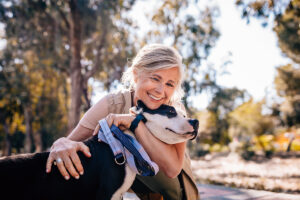
Ensuring a well-behaved walking experience with your dog requires some basic training and a lot of patience in many cases, but it is worth the effort.
Walking your dog on a leash can be a delightful experience for both you and your furry companion. However, without proper training and guidance, it can quickly turn into a frustrating ordeal. Leash pulling, zigzagging, and unruly behavior can take the joy out of your outdoor adventures. But fear not! With some patience, consistency, and the right techniques, you can have a well-behaved walking partner by your side.
Start with Basic Obedience Training
Before you even think about hitting the streets, ensure your dog has a solid foundation in basic obedience commands like “sit,” “stay,” and “heel.” These commands lay the groundwork for successful leash walking and general good behavior.
Choose the Right Equipment
Selecting the appropriate leash and collar/harness is essential. A standard six-foot leash is generally the most practical, giving your dog enough room to move without giving them too much freedom. Opt for a well-fitting harness instead of a collar, especially for dogs prone to pulling. Harnesses distribute pressure more evenly, reducing the risk of neck strain. Also available are head harnesses, which, when used correctly, are a great control tool.
Practice Patience
Leash training takes time, so be prepared to invest some effort. Remember that consistency is key. Stay patient and avoid getting frustrated if progress is slow.
Use Positive Reinforcement
Reward your dog for good behavior. Use treats, praise, and petting as positive reinforcement when they walk calmly by your side. This encourages them to associate leash walking with positive experiences.
Choose the Right Time and Place
Start training in a quiet, low-distraction environment. As your dog gets more accustomed to walking on a leash, gradually introduce them to busier areas. Avoid areas with heavy foot traffic or other dogs initially, as these distractions can impede their progress.
Master the “Heel” Command
Teaching your dog to walk beside you rather than ahead is crucial. Practice the “heel” command by using treats to keep your dog’s attention focused on you as you walk. Gradually increase the duration of walking at your side before giving a treat.
Stop Moving When They Pull
If your dog starts pulling, stop walking immediately. Stand still and wait for them to return to your side. Once they do, praise and reward them. This teaches your dog that pulling won’t get them where they want to go.
Change Directions
Keep your dog on their toes (or paws) by changing directions frequently during walks. This helps maintain their focus on you and discourages mindless pulling.
Use Engaging Toys
Carry a favorite toy during walks to redirect your dog’s attention from distractions. A squeaky toy or a tug rope can be great tools to keep them engaged.
Gradual Exposure to Distractions
As your dog becomes more comfortable with leash walking, introduce them to various distractions, such as other dogs, cyclists, or joggers. Use treats and commands to guide their behavior around these distractions. Dial it back down if they struggle to handle these distractions too much at first.
Be Consistent with Commands
Use consistent verbal cues, like “heel” or “let’s go,” to signal your dog to pay attention and walk calmly. Over time, they’ll start to associate these commands with appropriate behavior.
Seek Professional Help If Needed
If you’re struggling with leash training, consider seeking help from a professional dog trainer. They can offer personalized guidance and tailor their approach to your dog’s specific needs.
Trust Maryland Veterinary Surgical Services With Your Companion’s Health
Your companion’s health is important, and the team at MVSS is ready to provide the best care possible for your furry family. We are dedicated to combining comprehensive exams and assessments with informative and honest discussions of your companion’s care. Once we have worked with you to decide on the best course of action for your dog, our professionals will use their surgical expertise to work towards the goal of giving your companion an active and pain-free life. We are proud to serve loyal companions in Catonsville and Baltimore. To learn more about our services, give us a call at 410-788-4088 or visit us online. For more information and tips for pet health, follow us on Facebook and Pinterest.
